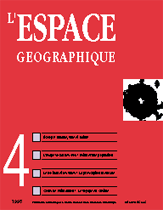

Nathalie BLANC. 1925-1990: Urban ecology and the relationship between city and nature. (1 tabl.)
Legislation and practice increasingly refer to urban ecology. This shows the growing importance of environmental issues in the search for solutions to the urban crisis and has led researchers to investigate the relevance of reintroducing nature into urban analysis. The author of this paper proposes an examination of urban ecology through definitions, methods and tools implemented at differents times, which may be of heuristic value in the study of the relationship between city and nature.
keywords: RELATIONSHIP BETWEEN CITY AND NATURE, URBAN ANALYSIS, URBAN ECOLOGY
Bernard SCHÉOU. Estimating the local population using the negative exponential density function. (11 tabl., 10 fig., 1 annexe)
Population is a variable commonly used in the construction of aggregate models, especially in the fields of regional and transport planning. But estimating the future population of a small area, such as a municipality, is particularly difficult. In the early 1970s, many researchers worked on the location of urban population using the negative exponential density function. This article examines the scope and limitations of this model for projecting the population of the smallest French administrative divisions (communes), based on a case study of the Lyon conurbation.
keywords: DENSITY FUNCTION, MODELLING, POPULATION PROJECTION
Municipal player's appropriation of geographical information technologies. (1 tabl., 2 fig.)
This article seeks to enhance our understanding of the criteria that influence the appropriation of Geographical Information Technologies (GIT) by those involved in land use planning at a municipal level. The results of this analysis provide clear evidence of close links between municipal players' perceptions (of the local area, of their own role, of the utility of these tools and of geographical information) and the extent to which they use these tools. The results reveal GIS as veritable social constructions, characterised by diverse forms of appropriation of the associated technologies and of the geographical information derived from them.
keywords: APPROPRIATION, GIS, LOCAL ADMINISTRATION, SPATIAL REPRESENTATIONS
Isabelle COLIN. Inequalities in medical prescriptions in an urban area. (12 fig.)
This paper examines the activity of general practitioners through their prescriptions of pharmaceuticals and medical certificates issued for paid sick leave. Sharp social disparities appear between different neighbourhoods, which are not correlated to demographic criteria (age or sex ratio). The spatial distribution of the practitioners leads to social segregation in access to health supplies: lower rates of prescription are correlated to high social status groups, but also to precarity.
keywords: HEALTH, ROUEN, SEGREGATION, SOCIAL CLASSES
Hierarchies of cities, hierarchies of sport clubs: the divergence of French football from the European norm. (7 fig.)
In Europe, the location of high-level football clubs reflects the hierarchy of cities. France, however, offers a different model, illustrated by the presence of small towns in first and second division football. This situation is based on an original structure, created by a mixture of public investment and permanent reference to the local area. Against a general background of metropolisation, this distribution appears to be an exception in the sports world and one that will be difficult to maintain.
keywords: EUROPE, FOOTBALL, FRANCE, SYSTEM, URBAN HIERARCHY
Annick HOLLÉ. The Newar courtyards in Kathmandu. (7 fig.)
This article offers a socio-spatial interpretation of a particular urban space in the Kathmandu valley: the courtyard. In this Hindu region, the spatial distribution of the population according to social status (caste) is a major determinant in the organisation of the town. The courtyards, omnipresent patterns in the old city centre, are divided into categories, according to their forms, inhabitants and traditional uses. By examining these three aspects, we seek to show the prominent part played by the courtyard in the everyday life of the inhabitants and the quality of space they offer.
keywords: CASTE SYSTEM, CITY COURTYARD, HOUSING, NEPAL, SOCIO-SPATIAL DIVISIONS
Vincent CLÉMENT. Romantic perception of Castile through account of Théophile Gautier's travel. (1 fig.)
Since 17th century, the representations of Spain in Europe had depended on the perception of Castile by foreign travellers. Théophile Gautier is the romantic writer who best understood this country, outside the Pyrenean mountains. He knew how to find a balance between his romantic exaltation and his intention to bear witness to the regions of Spain through which he had travelled. In his account, Voyage en Espagne (1843), the author analyses the picturesque qualities of the places seen by Théophile Gautier, and compares his descriptions of the landscapes of Castile with the reality of the terrain.
keywords: CASTILE, LANDSCAPE, ORIENTALISM, PERCEPTION, PICTURESQUE, ROMANTISM
L’espace géographique 3/98![]()
![]() L’espace géographique 1/99
L’espace géographique 1/99
![]() L’Espace géographique: contents
L’Espace géographique: contents
Last modified: Juanary 11, 1998